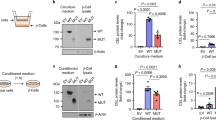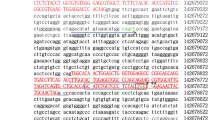Abstract
In congenital hyperinsulinism of infancy (CHI), the loss of K-ATP channels (composed of Kir6.2 and SUR1 subunits) in β cells induces permanent insulin secretion and severe hypoglycaemia. By contrast, Sur1 −/− mice do not present such defects. We have investigated the impact of Sur1 gene inactivation on mouse islet cell morphology, structure and basic physiology. Pancreata were collected from young, adult and old wild-type (WT) and Sur1 −/− mice. After immunostaining for hormone, the total endocrine tissue, cell proportion, cell size and intra-insular distribution, hormone content and Glut-2 expression were quantified by morphometry. Basic physiological parameters were also measured. In young Sur1 −/− mice, the total endocrine tissue and proportion of β cells were higher (P<0.05) than in WT mice, whereas the proportion of δ cells was lower (P<0.01). In old Sur1 −/− mice, α cells were frequently located in the central regions of islets (unlike WT islets) and their proportion was increased (P<0.05). Glut-2 protein and mRNA levels were lower in old Sur1 −/− islets (P<0.02). Insulinaemia, fasting insulin and glucagon contents were equivalent in both groups of pancreata. Thus, the islets of Sur1 −/− mice present morphological modifications that have not been described in CHI and that might reflect an adaptive mechanism controlling insulin secretion in these mice.




Similar content being viewed by others
References
Aguilar-Bryan L, Nichols CG, Wechsler SW, Clement JP 4th, Boyd AE 3rd, González G, Herrera-Sosa H, Nguy K, Bryan J, Nelson DA (1995) Cloning of the beta cell high-affinity sulfonylurea receptor: a regulator of insulin secretion. Science 268:423–426
Ashcroft FM, Gribble FM (1998) Correlating structure and function in ATP-sensitive K+ channels. Trends Neurosci 21:288–294
Bokvist K, Olsen HL, Hoy M, Gotfredsen CF, Holmes WF, Buschard K, Rorsman P, Gromada J (1999) Characterisation of sulphonylurea and ATP-regulated K+ channels in rat pancreatic A-cells. Pflügers Arch Eur J Physiol 438:428–436
Bosco D, Orci L, Meda P (1989) Homologous but not heterologous contact increases the insulin secretion of individual pancreatic beta-cells. Exp Cell Res 184:72–80
Bouwens L, Rooman I (2005) Regulation of pancreatic beta-cell mass. Physiol Rev 85:1255–1270
Brereton HC, Carvell MJ, Asare-Anane H, Graham R, Michael RC, Shanta JP, Peter MJ (2006) Homotypic cell contact enhances insulin but not glucagon secretion. Biochem Biophys Res Commun 344:995–1000
Brissova M, Fowler MJ, Nicholson WE, Chu A, Hirshberg B, Harlan DM, Powers AC (2005) Assessment of human pancreatic islet architecture and composition by laser scanning confocal microscopy. J Histochem Cytochem 53:1087–1097
Cabrera O, Berman DM, Kenyon NS, Ricordi C, Berggren PO, Caicedo A (2006) The unique cytoarchitecture of human pancreatic islets has implications for islet cell function. Proc Natl Acad Sci USA 103:2334–2339
Detimary P, Jonas JC, Henquin JC (1996) Stable and diffusible pools of nucleotides in pancreatic islet cells. Endocrinology 137:4671–4676
Dunne MJ, Kane C, Shepherd RM, Sanchez JA, James RF, Johnson PR, Aynsley-Green A, Lu S, Clement J, Lindley KJ, Seino S, Aguilar-Bryan L (1997) Familial persistent hyperinsulinaemic hypoglycaemia of infancy and mutations in the sulfonylurea receptor. N Engl Med 336:703–706
Esni F, Täljedal IB, Perl AK, Cremer H, Christofori G, Semb H (1999) Neural cell adhesion molecule (N-CAM) is required for cell type segregation and normal ultrastructure in pancreatic islets. J Cell Biol 144:325–337
Falkmer S, Søvik O, Vidnes J (1981) Immunohistochemical, morphometric, and clinical studies of the pancreatic islets in infants with persistent neonatal hypoglycemia of familial type with hyperinsulinism and nesidioblastosis. Acta Biol Med Ger 40:39–54
Fournet JC, Junien C (2004) Genetics of congenital hyperinsulinism. Endocr Pathol 15:233–240
Glaser B, Kesavan P, Heyman M, Davis E, Cuesta A, Buchs A, Stanley CA, Thornton PS, Permutt MA, Matschinsky FM, Herold KC (1998) Familial hyperinsulinism caused by an activating glucokinase mutation. N Engl J Med 338:226–230
Goossens A, Gepts W, Saudubray JM, Bonnefont JP, Nihoul-Fékété C, Heitz PU, Klöppel G (1989) Diffuse and focal nesidioblastosis: a clinicipathological study of 24 patients with persistent neonatal hyperinsulinaemic hypoglycaemia. Am J Surg Pathol 13:766–775
Göpel SO, Kanno T, Barg S, Rorsman P (2000) Patch-clamp characterisation of somatostatin-secreting δ-cells in intact mouse pancreatic islets. J Physiol (Lond) 528:497–507
Gromada J, Ma X, Hoy M, Bokvist K, Salehi A, Berggren PO, Rorsman P (2004) ATP-sensitive K+ channel-dependent regulation of glucagon release and electrical activity by glucose in wild-type and SUR1−/− mouse α-cells. Diabetes 53:S181–S189
Guiot Y, Henquin JC, Rahier J (1994) Effects of glibenclamide on pancreatic beta-cell proliferation in vivo. Eur J Pharmacol 261:157–161
Guiot Y, Stevens M, Marhfour I, Stiernet P, Mikhailov M, Ashcroft SJH, Rahier J, Henquin JC, Sempoux C (2007) Morphological localisation of sulfonylurea receptor 1 in endocrine cells of human, mouse and rat pancreas. Diabetologia 50:1889–1899
Hamaguchi K, Utsunomiya N, Takaki R, Yoshimatsu H, Sakata T (2003) Cellular interaction between mouse pancreatic alpha-cell and beta-cell lines: possible contact-dependent inhibition of insulin secretion. Exp Biol Med 228:1227–1233
Hauge-Evans AC, Squires PE, Persaud SJ, Jones PM (1999) Pancreatic beta-cell-to-beta-cell interactions are required for integrated responses to nutrient stimuli: enhanced Ca2+ and insulin secretory responses of MIN6 pseudoislets. Diabetes 48:1402–1408
Henquin JC (2000) Triggering and amplifying pathways of regulation of insulin secretion by glucose. Diabetes 49:1751–1760
Johnson JD, Ahmed NT, Luciani DS, Han Z, Tran H, Fujita J, Misler S, Edlund H, Polonsky KS (2003) Increased islet apoptosis in Pdx1+/− mice. J Clin Invest 111:1147–1160
Ku SK, Lee HS, Lee JH (2002) An immunohistochemical study on the pancreatic endocrine cells of the C57BL/6 mouse. J Vet Sci 3:327–333
Livak KJ, Schmittgen TD (2001) Analysis of relative gene expression data using real-time quantitative PCR and the 2−ΔΔCT method. Methods 25:402–408
Lonlay P de, Fournet JC, Rahier J, Gross-Morand MS, Poggi F, Foussier V, Bonnefont JP, Brusset MC, Brunelle F, Robert JJ, Nihoul-Fékété C, Saudubray JM, Junien C (1997) Somatic deletion of the imprinted 11p15 region in sporadic persistent hyperinsulinaemic hypoglycaemia of infancy is specific of focal adenomatous hyperplasia and endorses partial pancreatectomy. J Clin Invest 100:802–807
MacDonald PE, De Marinis YZ, Ramracheya R, Salehi A, Ma X, Johnson PR, Cox R, Eliasson L, Rorsman P (2007) A K ATP channel-dependent pathway within alpha cells regulates glucagon release from both rodent and human islets of Langerhans. PLoS Biol 15:233–240
Miki T, Tashiro F, Iwanaga T, Nagashima K, Yoshitomi H, Aihara H, Gonoi T, Inagaki N, Miyazaki J, Seino S (1997) Abnormalities of the pancreatic islets by targeted expression of a dominant-negative KATP channel. Proc Natl Acad Sci 94:11969–11973
Miki T, Nagashima K, Tashiro F, Kotake K, Yoshitomi H, Tamamoto A, Gonoi T, Iwanaga T, Miyazaki J, Seino S (1998) Defective insulin secretion and enhanced insulin action in KATP channel-deficient mice. Proc Natl Acad Sci USA 95:10402–10406
Nenquin M, Szollosi A, Aguillar-Bryan L, Bryan J, Henquin JC (2004) Both triggering and amplifying pathways contribute to fuel-induced insulin secretion in the absence of sulfonylurea receptor-1 in pancreatic beta-cells. J Biol Chem 279:32316–32324
Norman M, Moldovan S, Seghers V, Wang XP, DeMayo FJ, Brunicardi FC (2002) Sulfonylurea receptor knockout causes glucose intolerance in mice that is not alleviated by concomitant somatostatin subtype receptor 5 knockout. Ann Surg 235:767–774
Rahier J, Wallon J, Henquin JC (1981) Cell populations in the endocrine pancreas of human neonates and infants. Diabetologia 20:540–546
Rahier J, Fält K, Müntefering H, Becker K, Gepts W, Falkmer S (1984) The basic structural lesion of persistent neonatal hypoglycaemia with hyperinsulinism: deficiency of pancreatic D cells or hyperactivity of B cells? Diabetologia 26:282–289
Rahier J, Stevens M, De Menten Y, Henquin JC (1989) Determination of antigen concentration in tissue sections by immunodensitometry. Lab Invest 61:357–363
Rahier J, Guiot Y, Sempoux C (2000) Persistent hyperinsulinaemic hypoglycaemia of infancy: a heterogeneous syndrome unrelated to nesidioblastosis. Arch Dis Child Fetal Neonatal Ed 82:F108–F112
Seghers V, Nakazaki M, DeMayo F, Aguillar-Bryan L, Bryan J (2000) Sur1 knockout mice: a model for KATP channel-independent regulation of insulin secretion. J Biol Chem 275:9270–9277
Seino S, Miki T (2003) Physiological and pathophysiological roles of ATP-sensitive K+ channels. Prog Biophys Mol Biol 81:133–176
Seino S, Iwanaga T, Nagashima K, Miki T (2000) Diverse roles of KATP channels learned from Kir6.2 genetically engineered mice. Diabetes 49:311–318
Sempoux C, Guiot Y, Lefèvre A, Nihoul-Fékété C, Jaubert F, Saudubray JM, Rahier J (1998) Neonatal hyperinsulinaemic hypoglycaemia: heterogeneity of the syndrome and keys for differential diagnosis. J Clin Endocrinol Metab 83:1455–1461
Sempoux C, Guiot Y, Noel H, Jaubert F, Rahier J (2002) Persistent hyperinsulinemic hypoglycemia of infancy: the pathologist’s experience. Ann Pathol 22:375–386
Sempoux C, Guiot Y, Dahan K, Moulin P, Stevens M, Lambot V, Lonlay P de, Fournet JC, Junien C, Jaubert F, Nihoul-Fékété C, Saudubray JM, Rahier J (2003) The focal form of persistent hyperinsulinaemic hypoglycaemia of infancy: morphological and molecular studies show structural and functional differences with insulinoma. Diabetes 52:784–794
Shih DQ, Heimesaat M, Kuwajima S, Stein R, Wright CV, Stoffel M (2002) Profound defects in pancreatic β-cell function in mice with combined heterozygous mutations in Pdx-1, Hnf-1α and Hnf-3 β. Proc Natl Acad Sci USA 99:3818–3823
Shyng S, Nichols CG (1997) Octameric stoichiometry of the KATP channel complex. J Gen Physiol 110:655–664
Stanley CA, Lieu YK, Hsu BY, Burlina AB, Greenberg CR, Hopwood NJ, Perlman K, Rich BH, Zammarchi E, Poncz M (1998) Hyperinsulinism and hyperammonemia in infant with regulatory mutations of the glutamate dehydrogenase gene. N Engl J Med 338:1352–1357
Szollosi A, Nenquin M, Henquin JC (2007) Overnight culture unmasks glucose-induced insulin secretion in mouse islets lacking ATP-sensitive K+ channels by improving the triggering Ca2+ signal. J Biol Chem 282:14768–14776
Thomas P, Ye Y, Lightner E (1996) Mutation of the pancreatic islet inward rectifier Kir6.2 also leads to familial persistent hyperinsulinemic hypoglycemia of infancy. Hum Mol Genet 5:1809–1812
Tornovsky S, Crane A, Cosgrove KE, Hussain K, Lavie J, Heyman M, Nesher Y, Kuchinski N, Ben-Shushan E, Shatz O, Nahari E, Potikha T, Zangen D, Tenenbaum-Rakover Y, Vries L de, Argente J, Gracia R, Landau H, Eliakim A, Lindley K, Dunne MJ, Aguilar-Bryan L, Glaser B (2004) Hyperinsulinism of infancy: novel ABCC8 and KCNJ11 mutations and evidence for additional locus heterogeneity. J Clin Endocrinol Metab 89:6224–6234
Winarto A, Miki T, Seino S, Iwanaga T (2001) Morphological changes in pancreatic islets of KATP channel-deficient mice: the involvement of KATP channels in the survival of insulin cells and the maintenance of islet architecture. Arch Histol Cytol 64:59–67
Yamagata K, Nammo T, Moriwaki M, Ihara A, Lizuka K, Yang Q, Satoh T, Li M, Uenaka R, Okita K, Iwahashi H, Zhu Q, Cao Y, Imagawa A, Tochino Y, Hanafusa T, Miyagawa JI, Matsuzawa Y (2002) Overexpression of dominant-negative mutant hepatocyte nuclear factor-1α in pancreatic β-cells causes abnormal islet architecture with decreased expression of e-cadherin, reduced β-cell proliferation, and diabetes. Diabetes 51:114–123
Zhang C, Moriguchi T, Kajihara M, Esaki R, Harada A, Shimohata H, Oishi H, Hamada M, Morito N, Hasegawa K, Kudo T, Engel JD, Yamamoto M, Takahashi S (2005) MafA is a key regulator of glucose-stimulated insulin secretion. Mol Cell Biol 25:4969–4976
Acknowledgments
We thank M. Stevens and M. Nenquin for expert technical assistance and Dr. C. de Burbure for revising the manuscript.
Author information
Authors and Affiliations
Corresponding author
Additional information
This work was supported by grants 3.4616.05 (J.R.) and 9.4559.04 (C.S.) from the Fonds National de la Recherche Scientifique, Brussels, and by grant ARC 05/10–328 (I.M. and C.S.) from the Direction de la Recherche Scientifique de la Communauté Française de Belgique.
Rights and permissions
About this article
Cite this article
Marhfour, I., Moulin, P., Marchandise, J. et al. Impact of Sur1 gene inactivation on the morphology of mouse pancreatic endocrine tissue. Cell Tissue Res 335, 505–515 (2009). https://doi.org/10.1007/s00441-008-0733-2
Received:
Revised:
Accepted:
Published:
Issue Date:
DOI: https://doi.org/10.1007/s00441-008-0733-2




